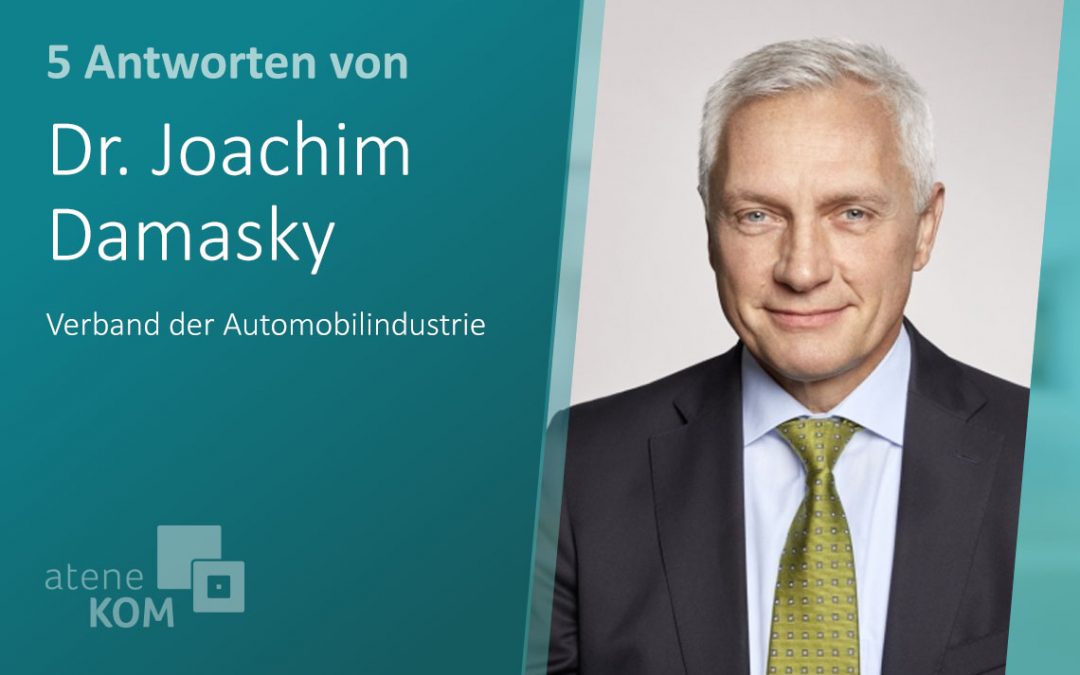It will be some time before vehicles are fully autonomous on the roads. First, the step towards automated driving must be taken. This means that the car carries out many processes autonomously and, in critical situations, prompts people to take over control of the vehicle again. Dr. Joachim Damasky, Managing Director of the German Association of the Automotive Industry (VDA), spoke to aconium GmbH about the conditions that need to be created for automated and later autonomous driving to become a reality in Germany.
aconium: Which technologies in the field of automated driving can drivers already use today?
Dr. Joachim Damasky: Since the introduction of the anti-lock braking system (ABS) in 1978, new driver assistance systems have been continuously developed. Today, for example, lane departure warning systems, cruise control and adaptive cruise control (ACC) take the strain off the driver. Parking assistants with combined longitudinal and lateral guidance are now also on the market. And systems are being introduced that also allow this combined longitudinal and lateral guidance to be operated from outside the vehicle. The tedious task of precise maneuvering is then taken over by the vehicle and the driver can leave the vehicle before it is parked in a tight side parking space.
aconium : What is your vision for the future of automated vehicles in Germany?
Dr. Damasky: In a few years, the first vehicles will be equipped with appropriate sensor technology and information processing that will enable automated and driverless driving functions for specific application scenarios. We initially expect automated driving functions for highways and, as a first step, for traffic jams. Further applications will follow on this basis. The aim is also to support journeys in urban or rural areas. However, the path to high and full automation is not just a technological one: the legal framework conditions must also be developed in unison both nationally and internationally.
aconium : What challenges does Germany currently face when it comes to automated driving?
Dr. Damasky: We are pushing ahead with connected and automated driving. To do this, however, we need an efficient digital infrastructure – in other words, nationwide coverage along state and federal highways, freeways and in industrial regions. Whether connected and automated driving becomes established in Germany in the coming years depends largely on the digital infrastructure in this country. The potential of automated and connected driving can only be fully exploited with comprehensive, dynamic mobile network coverage along all traffic routes.
aconium : What requirements must be met for vehicles to be fully autonomous on the roads in Germany?
Dr. Damasky: The technical regulations for the approval of the systems still need to be developed for automated driving – in other words, the driver takes control of the vehicle when the system prompts them to do so. This is being done internationally within the framework of the United Nations (UN) bodies. In the coming years, driverless driving will still be limited to specific and geographically restricted applications in conjunction with an operator. For these applications, the conditions for approval and operation must be formulated both nationally and internationally. This is because autonomous, i.e. driverless, vehicles are not yet eligible for approval in Germany outside of test applications.
aconium: What changes would you like to see in order for automated driving to be successfully introduced?
Dr. Damasky: I hope that more and more people will be convinced of the benefits of automated driving. The potential is truly enormous: automated driving increases road safety and gives drivers flexibility and time that they can use for other purposes. More and more people will still be able to be mobile in old age – either by using automated vehicles or supported by assistance systems in their own vehicle. Automated vehicles are more flexible than a bus, which makes living in the countryside more attractive again. It should also not be forgotten that freight and distribution traffic can be made much more efficient and environmentally friendly with automated systems. Further information on the subject of mobility can be found in the Transport and Environment series published by aconium GmbH.

